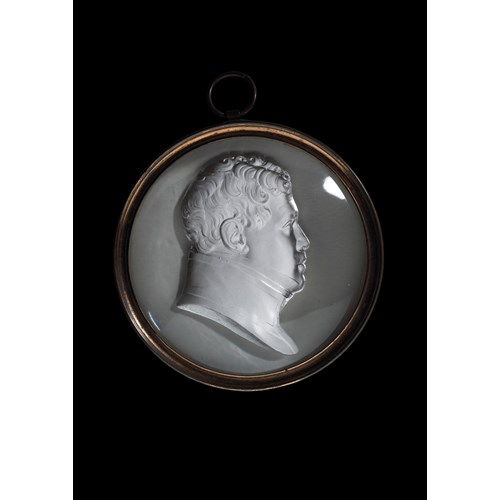Equestrian Monument of Emperor Marcus Aurelius (121 – 180 A.D.), after the Antique
Period 18th century
Medium Marble
Dimension 102 x 38 x 80 cm (40¹/₈ x 15⁰/₁ x 31¹/₂ inches)
Owing to its unique history, nature and, arguably, clear association to notions of political power and splendour, the Capitoline Marcus Aurelius enjoyed uninterrupted fame throughout the centuries. For example, “a very similar story was repeated of Michelangelo, of Pietro da Cortona, of Bernini and of Carlo Maratta, each of whom was supposed to have addressed the statue with the words ‘Move on, then; don’t you know that you are alive?’ (Taste and the Antique, p. 254). In the eighteenth century, at the highpoint of Neo-classicism, models after antique sculptures ranked amongst a collector’s most prized possessions, and the Marcus Aurelius was no exception.
The present Equestrian monument of Emperor Marcus Aurelius is exceptional amongst the known models after the Roman bronze in the Musei Capitolini, for its size, material and for the extraordinary quality of its finish. A characteristic that appears unique to it is the inscription on the base, in Italian, which reads “The people will be happy when they will have philosophers as kings or when their kings will be philosophers”. A reference to the Greek philosopher Plato’s concept of the “philosopher-king” as the most desirable form of government (The Republic, book VI), it came to be associated with Marcus Aurelius on account of his having been both an emperor and a philosopher.
Carved in statuary marble, this model of the Capitoline monument beautifully and attentively captures every anatomical and decorative detail of the prototype, from the torsion of the horse’s neck and the veins on its muzzle to the solemn expression in the Emperor’s face and the elaborate design of his saddle. This suggests our artist was able to observe the bronze first hand in Rome, fully taking in its sense of grandeur and movement. An accomplished sculptor, he rendered skilfully the folds in the Emperor’s robes, the deeply-carved curls in his hair and beard, and the potent tension in the horse’s stride. Perfectly aware of the different precautions required for sculpting in marble as opposed to casting in bronze, he inserted in the composition the armour of a defeated enemy – taken from images of Roman triumphs – which bears the weight of the composition in the centre, and added small supports to secure the horse’s legs and tail.
The crisp, confident quality of the modelling and the observant approach to the prototype discernible in our sculpture indicate that it was carved in a Roman workshop in the second half of the eighteenth century. Amongst the finest and most important of them was that of Carlo Albacini (1739-after 1807), with whose style the present Marcus Aurelius displays close parallels. A pupil of Bartolomeo Cavaceppi, Albacini specialised in copies after the antique of the highest refinement, destined to the wealthiest and most sophisticated Grand Tour travellers, but also in restoring antiquities, such as those in the prestigious Farnese collection. In 1783 he was accepted as an “accademico di merito” in the Accademia di S. Luca, Rome’s prestigious academy of arts. The Empress of Russia, Catherine II, is portrayed in a full-length statue by Albacini, whose works were in high demand at her court. She also commissioned him the funerary monument to the great painter Anton Rafael Mengs (1780) in the church of SS. Michele e Magno in Rome. Greatly admired within the milieu of English antiquarians and collectors in Rome, Albacini often collaborated with the art dealer Thomas Jenkins, and worked for prominent patrons such as Charles Townley, Henry Blundell and the Marquess of Lansdowne.
Albacini’s style centres on close observation of antique originals, and fully embodies the rigorously antiquarian aesthetic of Neo-classicism, an approach certainly informed by his activity as a restorer of ancient statues. In this field, conversely to his master Cavaceppi, Albacini showed a propensity to integrating antiquities to the highest finish, restoring them to what he deemed was their original splendour. The present artist, whose Marcus Aurelius does full justice to the ancient bronze and who shows extensive knowledge of ancient statuary and iconography, no doubt belonged to Albacini’s circle in Rome.
An interesting point of reference for our Marcus Aurelius is a marble model of the same subject, of comparable dimensions, now in Slane Castle, County Meath, Ireland. Virtually the only other large-scale Marcus Aurelius in marble known today, it offers an indication of the type of setting such sculptures would have been intended for, although the Italian inscription on our base suggests it was intended for the grand residence of an Italian patron, possibly a Roman patrician.
Period: 18th century
Medium: Marble
Signature: Inscribed “I POPOLI SARANNO FELICI QVANDO AVRANNO DEI FILOSOFI PER RE O CHE I LORO RE SARANNO DEI FILOSOFI” - “The people will be happy when they will have philosophers as kings or when their kings will be philosophers”
Dimension: 102 x 38 x 80 cm (40¹/₈ x 15⁰/₁ x 31¹/₂ inches)
Provenance: Sandoz Family collection
Private collection, Rome
Literature: Related Literature
F. Haskell and N. Penny, Taste and the Antique: The Lure of Classical Sculpture 1500 – 1900, New Haven and London, 1981, pp. 252-255
S. Howard, “Ancient Busts and the Cavaceppi and Albacini casts”, Journal of the History of Collections, vol. III, no. 2, January 1991, pp. 199–217
V. Coltman, Classical Sculpture and the Culture of Collecting in Britain since 1760, Oxford, 2009, pp. 85-87
More artworks from the Gallery


, after the Antique_T637828580940275284.jpg?width=2000&height=2000&mode=max&scale=both&qlt=90)






